MARIANI’S
December
31, 2006
NEWSLETTER
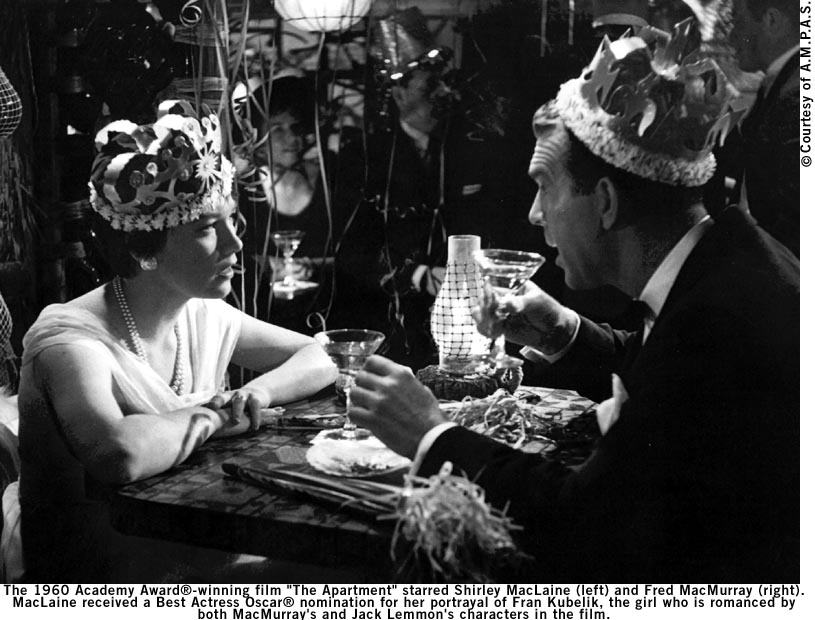
WEBSITE: To
go to my web site, in which I will update food
&
travel information and help link readers to other first-rate travel
& food sites, click on: home page
ARCHIVE: Readers may now access
an
Archive of all past newsletters--each annotated--dating back to July,
2003, by simply clicking on www.johnmariani.com/archive
.
SUBSCRIBE AND UN-SUBSCRIBE:
You may subscribe anyone you wish
to this newsletter--free of charge--by
clicking here.
In
This Issue
NEW YORK CORNER: kobe club by John Mariani
NOTES FROM THE WINE CELLAR: Beaujolais Non-Nouveau Deserves New Respect
by John Mariani
QUICK BYTES
~~~~~~~~~~~~~~~~~~~~~~~~~~~
The Sort of Secret Pleasures of Trento
by John Mariani
T rento. . . T rento. . . now where exactly is T rento?
 We stayed at the 126-room Grand Hotel
Trento (left; 1/3 Via Alfieri;
0461-271-000), which, though
opened a century ago, is probably the most modern and best run in the
region. Our room was nothing to rave about, but the concierge and staff
were efficient and helpful. We arrived in the evening, tossed our bags
onto the bed and went strolling the piazza in the moonlight, stopping
for dinner at Scrigno del Duomo (29 Piazza del Duomo; 0461-220030),
which is set on two levels, with a lively casual wine bar upstairs and
a beautiful
subterranean restaurant (below),
built on an ancient Roman well, and whose Senesi Room is named after the artist whose graffiti (in the best sense)
are etched in the walls here.
We stayed at the 126-room Grand Hotel
Trento (left; 1/3 Via Alfieri;
0461-271-000), which, though
opened a century ago, is probably the most modern and best run in the
region. Our room was nothing to rave about, but the concierge and staff
were efficient and helpful. We arrived in the evening, tossed our bags
onto the bed and went strolling the piazza in the moonlight, stopping
for dinner at Scrigno del Duomo (29 Piazza del Duomo; 0461-220030),
which is set on two levels, with a lively casual wine bar upstairs and
a beautiful
subterranean restaurant (below),
built on an ancient Roman well, and whose Senesi Room is named after the artist whose graffiti (in the best sense)
are etched in the walls here.The winelist here is one of the finest I've seen in Italy, specializing in the varietals
We began with complimentary glasses of prosecco with a puree of duck liver with greens and a touch of balsamic vinegar, along with a fillet of triglie (mullet) with a salad of zucchini.
Our pastas were wonderfully northern in style, like saffron-flavored matagliati with rabbit and asparagus, and ravioli packed with roe deer meat and glossed with butter. Cannelloni with a leek puree and wonderfully sweet, just barely stewed tomatoes, though a slice of anchovy didn't help the dish at all. Typical of the region were canerderli--fried dumplings with plums and a surprisingly good grapefruit sorbet. With these courses Photo: Galina Stepanoff-Dargery
A meal here should run about $60 per person, with tax and service.
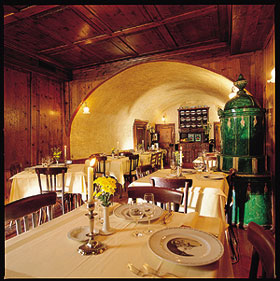 Osteria Due Spade (11 Via Don Rizzi; 0461-234-3430 )
has its own ancient charms, though they date back merely to the 16th
century, when this was already considered a fine place to stop for a
meal. It
is rustic and elegant at the same time, with a lovely outdoor
patio under a canvas canopy; the small dining room has fine
woodwork and an old Majolica stove.
Osteria Due Spade (11 Via Don Rizzi; 0461-234-3430 )
has its own ancient charms, though they date back merely to the 16th
century, when this was already considered a fine place to stop for a
meal. It
is rustic and elegant at the same time, with a lovely outdoor
patio under a canvas canopy; the small dining room has fine
woodwork and an old Majolica stove.Federico Paterlari is a young chef well on his way to high repute (like Scrigno del Duomo, Due Spade has a Michelin star). He changes his menus seasonally, keeping them to just five antipasti, five pastas, and six main courses, delighting in dishes of autumn and winter with game, truffles, and sweet-sour flavors mingled with tuber vegetables. He lards pheasant with black truffles and does a napoleon of potatoes and artichoke with thin slices of bresaola made from a local specialty, horsemeat. Desserts are more Austrian than Italian, and all the better for it. Dinner will cost about $70 per person, with tax and service included.
Somewhat more staid, with white columns, stucco ceiling, red velvet chairs, and soft lighting is Ristorante Chiesa (9 Via Marchetti; 0461-238-766; right), known for its very old traditional Trentino recipes and its apple menu. We chose an antipasto of Speck ham, a light and delicate cheese strüdel not unlike a quiche, and a crostino (puff pastry) of herring mixed with apples still ripe and firm to the bite. .
One caveat about a former favorite in the area. Pizzeria Laste in the nearby village of Cognola seems to have drifted from serving one of the best pizzas in northern Italy to serving only a pretty good one. And for what it takes to find the place, which doesn't look like much, we hesitate to suggest you make the trek. It used to be worth the effort, but not now.
From Trento you may head out through the Dolomites and explore the gorgeous lake country, and because of its proximity, trips into Switzerland and Austria are easy enough. And in so doing you can see--and taste--how the cultures have overlapped, and, however much things may change in the world, good food and wine endures.
NEW YORK CORNER
by John Mariani
Photos by Michael Katz
212-644-5623

Kobe beef (the name is a misnomer for wagyu beef that was originally raised around the city of Kobe) is, as everyone now knows, cut from highly pampered steers fed a specific diet meant ot build up massive amounts of fat with the muscle tissue. It was difficult to obtain and very expensive. The USDA banned wagyu from importation for years, only allowing it in again as of December 2005. In the meantime American and Australian farmers built herds of steers similar to the original Japanese breeds, which are--or should be labeled--Kobe-style beef. So, how, suddenly, can so many American steakhouses now claim to have wagyu beef?
Yet it has entered the market, and if people are willing to pay in excess of $100 a pound, you can get it. Last week I reported on the excellent, buttery Japanese Kobe beef at Megu Midtown, and you can now find the same beef in an increasing number of places in New York, Las Vegas, and L.A. (the best I've tasted was at Cut in L.A.).
Now
comes China Grill
Management with a bold statement that the specialty of the house is the
name of
the house--Kobe Club, which takes over the flubbed Alain Ducasse
restaurant Mix
on this site. Decor-wise everything has been radically
transformed:
The premises are now dark and shadowy, the tones black and gray, the
lighting
low, and the ceiling hung with 2000 samurai swords that put you in mind
of a sleek Goth meeting place. The
60-seat dining room has been drawing a
young, casually dressed crowd
that seems as interested in the sexy bar upfront as the dining room to
the rear,
and you can count on loud disco music to add to the decibel level at
Kobe
Club. When I visited it looked like a lot of people were blowing
some of their Christmas bonus money at the restaurant.
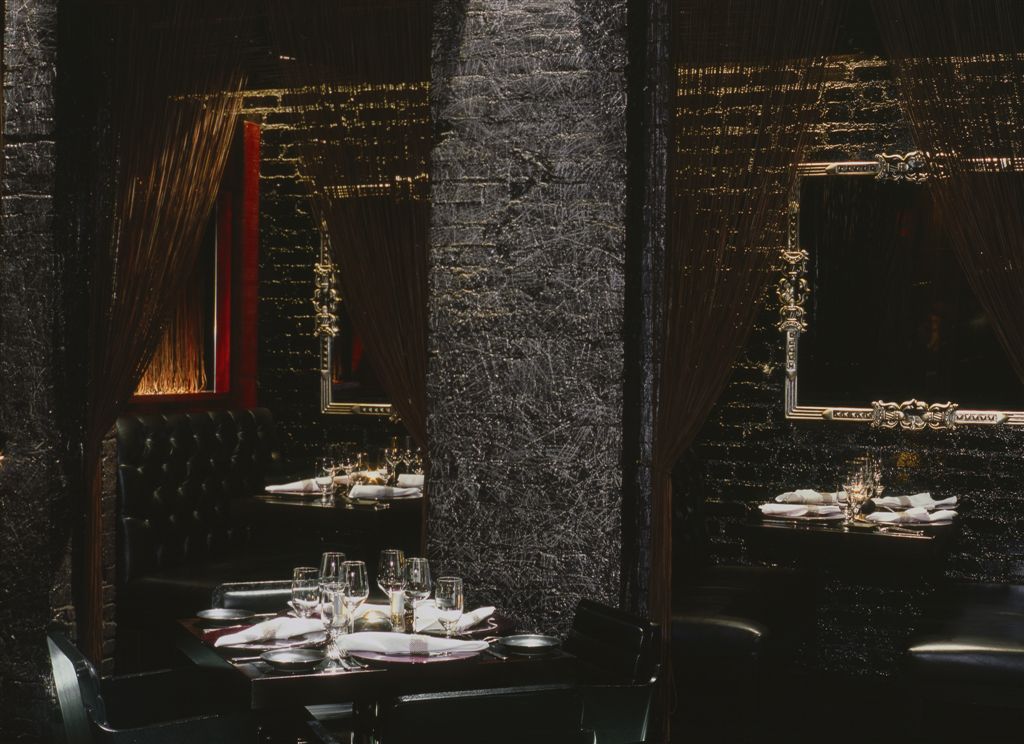
Kobe
Club offers three styles of its signature item--
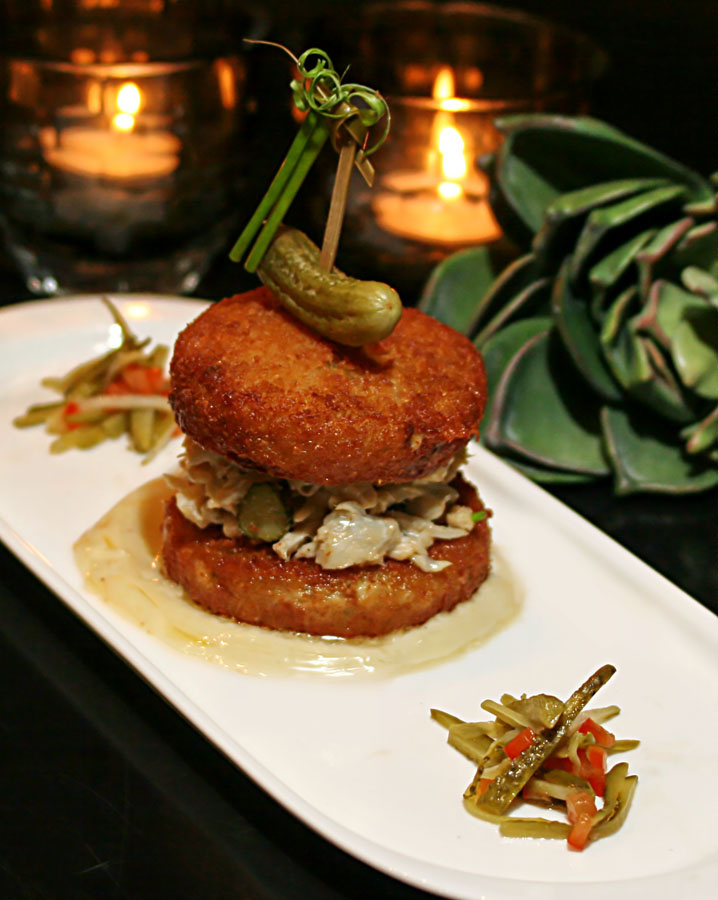 The accompaniments are as special as the meats, including
a number of
sauces
you may or may not wish to increase the heft of the meal.
The accompaniments are as special as the meats, including
a number of
sauces
you may or may not wish to increase the heft of the meal.
Kobe Club's winelist had more than 250 labels, with a
good selection that won't break the bank, along with a reserve list
that gives the bonus babies of Wall Street something to splurge on.
Make no mistake: This is one of the most expensive restaurants in the
U.S., where you can easily spend $200 a person--a half-pound slab of
Japanese filet runs $190, and a 28-0unce Australian porterhouse
$390--but you're getting top quality. It is an extravagance and one
that can only be digested in small quantities. Kobe Club has to
decide what exactly it
wants to be--a notable restaurant with a distinctive signature or a
hang-out
place for people to come and drink and splurge on expense
account. I doubt
it can be both, but right now, you'll eat very well here if you truly
love this
kind of extremely rich fare.
Kobe
NOTES FROM THE WINE CELLAR
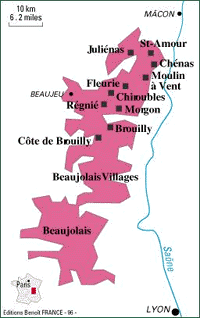 Beaujolais Non-Nouveau
Deserves New
Respect
Beaujolais Non-Nouveau
Deserves New
Respect
by John Mariani
Nothing could be further from the truth. Aged Beaujolais is a deep purple wine made from the Gamay Noir grape on hundreds of small to medium-sized properties over 55,000 acres in southern Burgundy that mostly sell their wine to distributors called negoçiants. The largest negoçiant, and the man who made his fortune promoting Beaujolais Nouveau, is Georges DuBoeuf (below), who controls more than 10 percent of total production and still devotes more than a fifth of that to Beaujolais Nouveau--4 million bottles annually, with about 2.4 million shipped to the U.S. Overall the region produces about 13 million cases of Beaujolais annually. One-third to one-half can be Beaujolais Nouveau, of which Japan takes 11 million bottles.
Beaujolais’ reputation has not been helped by its association as the ubiquitous “bistro wine,” cheap, low-alcohol wines drunk in carafes throughout France. And for decades up until the 1990s many of the vineyards were ill-tended, producing bulk wines for that bistro market.
But the better Beaujolais have since the 1990s come from vineyards brought to modern standards of viticulture, especially in those appellations granted status as Beaujolais-Villages, whose wines must have a minimum of 10 percent alcohol and now constitute about one-quarter of total production. The best Beaujolais, whose alcohol tilts more towards 13 percent--come from ten regulated crus—Brouilly, Chénas, Chiroubles, Côte de Brouilly, Fleurie, Juliènas, Moulin-à-Vent, Morgon, Saint-Amour, and Régnié. By common agreement, Beaujolais Nouveau cannot be made from these crus.
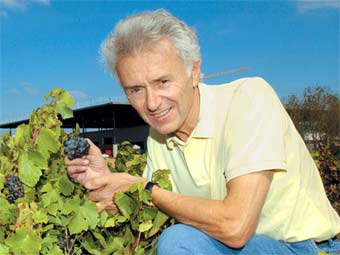
Distancing themselves from the Beaujolais Nouveau hysteria has become an important marketing point for these crus. For one thing Beaujolais Nouveau is made by a process called semicarbonic maceration (which Burgundy winemaker Jean-Marie Guffens calls “carbonic masturbation”). This creates chemical compounds that give the wines their characteristic tropical lollipop flavors.
Aged Beaujolais is made by traditional method of fermentation and aging, taking on nuances and balancing out flavors, acids, and oak. And while few other countries bother to trifle with Gamay, the grape shows its loveliest qualities in the crus of Beaujolais.
The crus most certainly improve with age, but age is relative. While Beaujolais Nouveau should be drunk immediately, the crus develop best at two to three years old. After that they become risky, either losing their fruit or tasting muddled. Some aficionados claim that some ten-year-old Beaujolais show amazing complexity, but very few connoisseurs would bother to cellar Beaujolais for such lengths of time.
Over two dinners at my home I sampled several crus that showed the distinctions among aged Beaujolais. One seemed most typical of the medium-body and grapey flavor of Gamay was the 2003 Domaine des Buyats Regnie ($12.99)—a translucent wine of 13 percent alcohol that went particularly well with a pasta dish of farfalle with funghi porcini, shallots, and garlic. It was not particularly impressive with a main course of roast pork loin, which was much better with a heartier, darker, 2003 Georges DuBoeuf Moulin-à-Vent ($14.99), which had great vigor and roundness, with deep purple color. I found a 2003 Fleurie Cuvée Prestige DuBoeuf ($16.99) one-dimensional and flat, too mellow, but it went nicely with a simple plate of fresh mozzarella and thin slices of Prosciutto di Parma.
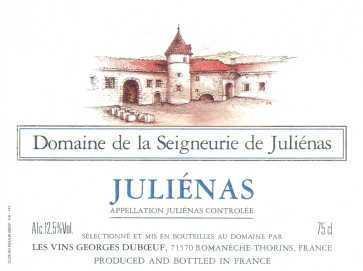 The next night, with a first
course of trenette pasta with
a
vegetable sauce, the best Beaujolais was a 2002
Domaine
de la Chaponne ($11.99), which had the signature flavor of Gamay. But
after a
single glass it lost its appeal. On the
other hand a 2002 Domaine de la Seigneurie, another of DuBoeuf's wines,
showed very well with a very
rare
porterhouse steak. Here was a very pretty wine, a straightforward
Beaujolais
with levels of flavor brought up with the succulence and fat of the
beef.
The next night, with a first
course of trenette pasta with
a
vegetable sauce, the best Beaujolais was a 2002
Domaine
de la Chaponne ($11.99), which had the signature flavor of Gamay. But
after a
single glass it lost its appeal. On the
other hand a 2002 Domaine de la Seigneurie, another of DuBoeuf's wines,
showed very well with a very
rare
porterhouse steak. Here was a very pretty wine, a straightforward
Beaujolais
with levels of flavor brought up with the succulence and fat of the
beef.As I drank the wine, I was truly reminded of those wonderful nights long ago in Paris when a steak with frites and a carafe of Beaujolais seemed like the best thing in the world. If Beaujolais cannot claim to be a great wine, it can certainly bring back into perspective the real joy of eating simply and drinking very well for very little.
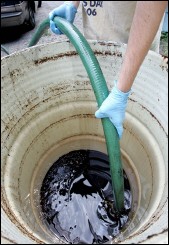
REVEALED AT LAST--THE SECRET INGREDIENT IN GENERAL TSO'S CHICKEN!
Notes from recipes in White Trash Gatherings by Kandra Bailey Morris
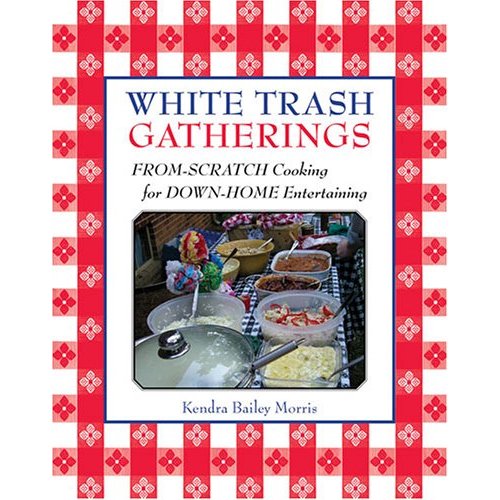
-MISS CYNDI'S WHITE TRASH SUSHI: The thought of eating raw fish wrapped up in seaweed would certainly send my granny a prayin', but wrap a dill pickle in white bread and cream cheese and she'll be singing "How Great Thou Art" in no time.
-LOU LOU'S FRIED SQUIRREL: After you shoot up a couple of tree rats, make sure to clean 'em real good.
-MISS MADDY'S JAPANESE FRUIT PIE: Don't let the name of this recipe fool you. There is absolutely nothing Asian in this pie unless you count the coconut, and according to my Aunt Maddy, that's enough to make it Japanese.
QUICK BYTES
*
* On Jan. 10
* During January, in
~~~~~~~~~~~~~~~~~~~~~~~~~~~~~~~~~~~~~~~~~~~~~~~~~~~~~~~~~~~~~~~~~~~~~~~~~
MARIANI'S VIRTUAL GOURMET NEWSLETTER is published weekly. Editor/Publisher:
John Mariani. Contributing Writers: Robert Mariani, Naomi
Kooker, Kirsten Skogerson, Edward Brivio, Mort
Hochstein, Suzanne Wright. Contributing
Photographers: Galina Stepanoff-Dargery, Bobby Pirillo. Technical
Advisor: Gerry McLoughlin.
Any of John Mariani's books below
may be ordered from amazon.com by clicking on the cover image.
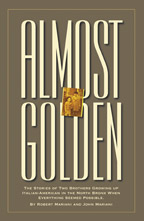 My
newest book, written with my brother Robert Mariani, is a memoir of our
years growing up in the My
newest book, written with my brother Robert Mariani, is a memoir of our
years growing up in the For those of you who don't think of the Robert and I think you'll enjoy this very personal look at our --John Mariani |
 |
 |
 |
 |
 |
 |
copyright John Mariani 2006